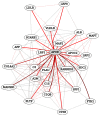Chapter 2: Data-driven view of disease biology
- PMID: 23300408
- PMCID: PMC3531282
- DOI: 10.1371/journal.pcbi.1002816
Chapter 2: Data-driven view of disease biology
Abstract
Modern experimental strategies often generate genome-scale measurements of human tissues or cell lines in various physiological states. Investigators often use these datasets individually to help elucidate molecular mechanisms of human diseases. Here we discuss approaches that effectively weight and integrate hundreds of heterogeneous datasets to gene-gene networks that focus on a specific process or disease. Diverse and systematic genome-scale measurements provide such approaches both a great deal of power and a number of challenges. We discuss some such challenges as well as methods to address them. We also raise important considerations for the assessment and evaluation of such approaches. When carefully applied, these integrative data-driven methods can make novel high-quality predictions that can transform our understanding of the molecular-basis of human disease.
Conflict of interest statement
The authors have declared that no competing interests exist.
Figures







References
-
- Hegde P, Qi R, Gaspard R, Abernathy K, Dharap S, et al. (2001) Identification of tumor markers in models of human colorectal cancer using a 19,200-element complementary DNA microarray. Cancer Res 61: 7792–7797. - PubMed
-
- Lock C, Hermans G, Pedotti R, Brendolan A, Schadt E, et al. (2002) Gene-microarray analysis of multiple sclerosis lesions yields new targets validated in autoimmune encephalomyelitis. Nat Med 8: 500–508. - PubMed
-
- Schymick JC, Scholz SW, Fung HC, Britton A, Arepalli S, et al. (2007) Genome-wide genotyping in amyotrophic lateral sclerosis and neurologically normal controls: first stage analysis and public release of data. Lancet Neurol 6: 322–328. - PubMed
Publication types
MeSH terms
Grants and funding
LinkOut - more resources
Full Text Sources

